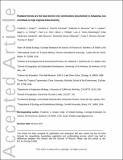Peatland forests are the least diverse tree communities documented in Amazonia, but contribute to high regional beta-diversity
Abstract
Western Amazonia is known to harbour some of Earth's most diverse forests, but previous floristic analyses have excluded peatland forests which are extensive in northern Peru and are among the most environmentally extreme ecosystems in the lowland tropics. Understanding patterns of tree species diversity in these ecosystems is important both for quantifying beta-diversity in this region, and for understanding determinants of diversity more generally in tropical forests. Here we explore patterns of tree diversity and composition in two peatland forest types – palm swamps and peatland pole forests – using 26 forest plots distributed over a large area of northern Peru. We place our results in a regional context by making comparisons with three other major forest types: terra firme forests (29 plots), white-sand forests (23 plots) and seasonally-flooded forests (11 plots). Peatland forests had extremely low (within-plot) alpha-diversity compared with the other forest types that were sampled. In particular, peatland pole forests had the lowest levels of tree diversity yet recorded in Amazonia (20 species per 500 stems, Fisher's alpha 4.57). However, peatland pole forests and palm swamps were compositionally different from each other as well as from other forest types in the region. Few species appeared to be peatland endemics. Instead, peatland forests were largely characterised by a distinctive combination of generalist species and species previously thought to be specialists of other habitats, especially white-sand forests. We suggest that the transient nature and extreme environmental conditions of Amazonian peatland ecosystems have shaped their current patterns of tree composition and diversity. Despite their low alpha-diversity, the unique combination of species found in tree communities in Amazonian peatlands augment regional beta-diversity. This contribution, alongside their extremely high carbon storage capacity and lack of protection at national level, strengthens their status as a conservation priority.
Citation
Draper , F C , Coronado , E N H , Roucoux , K H , Lawson , I T , Pitman , N C A , Fine , P V A , Phillips , O L , Montenegro , L A T , Valderrama Sandoval , E , Mesones , I , García-Villacorta , R , Arévalo , F R R & Baker , T R 2018 , ' Peatland forests are the least diverse tree communities documented in Amazonia, but contribute to high regional beta-diversity ' , Ecography , vol. Early View . https://doi.org/10.1111/ecog.03126
Publication
Ecography
Status
Peer reviewed
ISSN
1600-0587Type
Journal article
Description
FCD was supported by a NERC PhD Studentship (NE/ J50001X/1). Additional funding for the peatland fieldwork and floristic assessment was provided by a NERC Small Grant to KHR, TRB and IL (NE/H011773/1), The Royal Geographical Society, The Quaternary Research Association, The Anglo-Peruvian Society, the Earth and Space Foundation, and the Instituto de Investigaciones de la Amazonía Peruana. Plot installation, fieldwork and botanical identification in RAINFOR plots has been supported by several grants including a Gordon and Betty Moore Foundation grant to RAINFOR, the EU’s Seventh Framework Programme (283080, ‘GEOCARBON’) and NERC Grants to OLP (Grants NER/A/S/2000/0053, NE/B503384/1, NE/F005806/1, and a NERC Postdoctoral Fellowship), and a National Geographic Society for supporting forest dynamics research in Amazonian Peru (grant #5472-95). OLP is supported by an ERC Advanced Grant and is a Royal Society-Wolfson Research Merit Award holder. TRB acknowledges support from a Leverhulme Research Fellowship (RF-2015-653).Collections
Items in the St Andrews Research Repository are protected by copyright, with all rights reserved, unless otherwise indicated.

